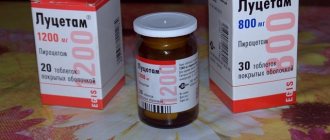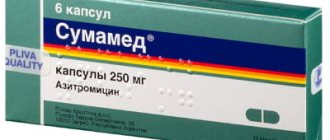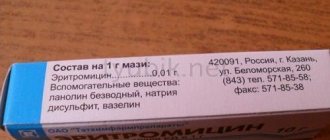Release form and composition
The dosage form of the drug is film-coated tablets: yellow, biconvex; dosage 200 mg - round, dosage 400 and 800 mg - oblong, with rounded ends and with a notch; on the cross section - the core is almost white or white (10, 15, 20 or 30 pieces in a strip pack; in a cardboard pack there are 1-10 or 12 packs and instructions for use of Piracetam Obolenskoye).
Composition per 1 tablet:
- active substance: piracetam – 200, 400 or 800 mg;
- additional substances: croscarmellose sodium (primellose), macrogol 6000 (polyethylene glycol 6000), colloidal silicon dioxide (Aerosil), magnesium stearate;
- film shell: Opadry II 85F – macrogol, polyvinyl alcohol, titanium dioxide, talc, aluminum varnish based on indigo carmine, aluminum varnish based on quinoline yellow.
Characteristics
Piracetam "Obolenskoye" is an effective drug that allows you to normalize the functioning of the brain damaged by the influence of various unfavorable factors. Belongs to the group of nootropics and psychostimulants.
The medicine contains the active ingredient - piracetam, as well as additional components. They are listed below:
- magnesium stearate;
- polyethylene glycol 6000;
- croscarmellose sodium;
- anhydrous colloidal silicon dioxide.
At the pharmacy you can buy Obolenskoe piracetam 800, 400 and 200 mg in cardboard boxes of 30 pieces. The tablets are oblong in shape and white in color.
The cost can vary from 25 to 98 rubles. It all depends on the region of your residence, the amount and dosage of the active substance.
According to many patients, they regularly undergo courses of treatment with the drug to eliminate unpleasant symptoms associated with the deterioration of the functioning of an important organ, especially since the low cost does not hit the pocket hard.
Before starting therapy, consultation with a doctor is required, because the tablets have a number of contraindications and side effects. If used incorrectly or dosage is calculated incorrectly, they can be harmful to health.
Pharmacological properties
Pharmacodynamics
Piracetam is a cyclic derivative of gamma-aminobutyric acid (GABA) and belongs to the group of nootropic drugs. It has a direct effect on the brain, providing improvement in cognitive processes - memory, attention, learning ability, as well as mental performance. The effect on the central nervous system (CNS) is manifested by changing the rate of propagation of excitation in the brain, improving metabolic processes in nerve cells, increasing microcirculation by improving the rheological parameters of the blood, but does not lead to vasodilation.
Piracetam inhibits platelet aggregation, restores the elasticity of erythrocyte membranes and reduces the degree of adhesion of the latter. When using the drug in a dose of 9.6 g, the level of fibrinogen and von Willebrand factor is reduced by 30–40%, and the bleeding time is prolonged. It helps improve communication between the cerebral hemispheres and synoptic conduction in neocortical structures. Against the background of impaired brain activity caused by hypoxia and intoxication, the drug exhibits a protective and restorative effect. Reduces the severity and duration of vestibular nystagmus.
Pharmacokinetics
When taken orally, piracetam is intensively and almost completely absorbed from the gastrointestinal tract (GIT). Its bioavailability reaches 100%. After a single dose of Piracetam Obolenskoye at a dose of 2,000 mg, the maximum concentration (Cmax) of the active substance is 40–60 mcg/ml and is observed in the blood after 30 minutes, and in the cerebrospinal fluid after 2–8 hours.
The apparent volume of distribution (Vd) of piracetam is on average 0.6 l/kg, the half-life (T1/2) from blood plasma is 4–5 hours, from cerebrospinal fluid – 8.5 hours.
The substance passes through the blood-brain barrier and placenta, as well as through hemodialysis membranes. In animal studies, it was found that piracetam selectively accumulates in the tissues of the cerebral cortex, mainly in the parietal, frontal and occipital lobes, basal ganglia and cerebellum. It does not interact with plasma proteins and does not undergo biotransformation in the body. It is eliminated unchanged almost completely (80–100%) by the kidneys through renal filtration. In healthy volunteers, the renal clearance of piracetam is 86 ml/min.
Indications for use
Indications for Piracetam Obolenskoe are:
- psychoorganic syndrome, in particular in elderly patients with such disorders as dizziness, memory loss, weakened concentration and general activity, behavioral disorders, mood changes, gait disturbances, as well as in patients with Alzheimer's disease, including senile dementia of the Alzheimer's type (symptomatic treatment);
- decreased motor and mental activity, speech disorders, emotional disturbances and other consequences of ischemic stroke;
- dizziness and balance disorders caused by it, except for dizziness of mental and vasomotor origin;
- cortical myoclonus (in monotherapy or as part of complex treatment);
- psychoorganic syndrome in children (as part of combination therapy for learning disabilities);
- chronic alcoholism, for the purpose of treating withdrawal and psychoorganic syndromes;
- sickle cell anemia (as part of combination therapy);
- recovery period after intoxication and brain injury.
Analogs
Popular substitutes for Piracetam are Nootropil and Lucetam.
Nootropil
Manufacturer – B Pharma S.A., Belgium
Price – 207 rubles
Description - capsules, medicinal solution or tablets improve the functioning of the central nervous system in Alzheimer's disease, alcohol addiction, psychoorganic syndrome
Pros – quality, effectiveness, really improves brain activity
Disadvantages – may interfere with sleep, cumulative effect, individual intolerance.
Lutsetam
Manufacturer – JSC Egis, Hungary
Price – from 65 rubles
Description – solution and tablets are prescribed for withdrawal symptoms, ischemic stroke, dizziness, brain injuries
Pros : good tolerability, ease of use, cost
Cons – may increase anxiety, unproven effectiveness, increases the effect of antipsychotics.
Contraindications
Absolute:
- the last stage of chronic kidney disease, with creatinine clearance (CC) below 20 ml/min;
- acute cerebrovascular accident (hemorrhagic stroke);
- breast-feeding;
- age up to 1 year;
- individual intolerance to piracetam, auxiliary components in the composition of tablets or pyrrolidone derivatives.
Pregnancy is a relative contraindication for the use of Piracetam Obolenskoe; the drug, as an exception, may be prescribed in special circumstances, provided that the potential benefit to the mother exceeds the risk of a negative effect on the development of the fetus.
Treatment of children
The drug is actively used in pediatric practice. According to the official instructions for use, Piracetam “Obolenskoye” is used for:
- hypoxia, asphyxia;
- injuries;
- developmental delay;
- increased excitability (hyperactivity);
- problems with attention;
- complications of encephalitis, meningitis;
- learning difficulties.
In most cases, a substance rarely acts as a monocomponent. Most often it is combined with other means. However, such a scheme must be regulated by a qualified specialist.
According to parents, after completing the course of treatment, many children showed significant improvement. The children behaved more calmly and easily remembered new information. My sleep became deeper and the nighttime cries stopped.
Piracetam "Obolenskoye" (800 mg) is not prescribed at an early age (up to 7 years).
The effectiveness of treatment mainly depends on correct use, so independent use may be useless and even harmful.
Piracetam Obolenskoe, instructions for use: method and dosage
Piracetam Obolenskoe film-coated tablets are taken orally, on an empty stomach or during meals with water or juice.
Doses of the drug can vary from 0.03 to 0.16 g/kg/day, divided into 2–4 doses.
Recommended daily doses of Piracetam Obolenskoe depending on the indications:
- psychoorganic syndrome (symptomatic therapy): 1.2–2.4 g, taking into account the severity of symptoms, during the first week - 4.8 g;
- dizziness and related balance disorders: 2.4–4.8 g;
- consequences of stroke: 4.8 g;
- cortical myoclonus: initial dose – 7.2 g, every 3-4 days the dose is increased by 4.8 g per day, to a maximum daily dose of 24 g; It is recommended to continue taking the combination of drugs used for the treatment of myoclonus at the same dose; therapy is carried out throughout the entire period of the disease, since during acute episodes of damage spontaneous improvement may occur, every 6 months it is necessary to make attempts to reduce the dose or discontinue Piracetam Obolenskoe, gradually reducing the dose by 1.2 g every 2 days (to prevent an attack); if there is little or no therapeutic effect, treatment with the drug should be discontinued;
- alcohol withdrawal syndrome: 12 g, maintenance dose 2.4 g;
- correction of learning disabilities in children: 3.3 g, therapy is continued throughout the entire year of study;
- sickle cell anemia: 0.16 g/kg, divided into 4 equal doses.
Piracetam obolenskoe
Manufacturer: FP OBOLENSKOYE CJSC (Russia)
tab., cover coated, 400 mg: 10, 15, 20, 30, 40, 45, 50, 60, 70, 75, 80, 90, 100, 105, 120, 135, 140, 150, 160, 180, 200, 210, 240 , 270, 300 or 360. Reg. No.: P No. 001564/01
Clinical and pharmacological group:
Nootropic drug
Release form, composition and packaging
Film-coated tablets
yellow, round, biconvex, oblong in shape with rounded ends, with a notch; On a cross section, two layers are visible.
| 1 tab. | |
| piracetam | 400 mg |
Excipients:
polyethylene glycol 6000, croscarmellose sodium (primellose), magnesium stearate, colloidal silicon dioxide (aerosil), hydroxypropylcellulose, titanium dioxide, quinoline yellow.
10 pieces. — cellular contour packages (3) — cardboard packs. 10 pieces. — contour cell packaging (6) — cardboard packs. 10 pieces. — cellular contour packages (1) — cardboard packs. 10 pieces. — contour cell packaging (5) — cardboard packs. 10 pieces. — contour cell packaging (4) — cardboard packs. 10 pieces. — contour cell packaging (7) — cardboard packs. 10 pieces. — contour cell packaging (8) — cardboard packs. 10 pieces. — contour cell packaging (9) — cardboard packs. 10 pieces. — contour cell packaging (10) — cardboard packs. 10 pieces. — contour cell packaging (12) — cardboard packs. 15 pcs. — contour cell packaging (12) — cardboard packs. 15 pcs. — cellular contour packages (1) — cardboard packs. 15 pcs. — cellular contour packages (3) — cardboard packs. 15 pcs. — contour cell packaging (2) — cardboard packs. 15 pcs. — contour cell packaging (4) — cardboard packs. 15 pcs. — contour cell packaging (5) — cardboard packs. 15 pcs. — contour cell packaging (6) — cardboard packs. 15 pcs. — contour cell packaging (7) — cardboard packs. 15 pcs. — contour cell packaging (8) — cardboard packs. 15 pcs. — contour cell packaging (9) — cardboard packs. 15 pcs. — contour cell packaging (10) — cardboard packs. 20 pcs. — contour cell packaging (10) — cardboard packs. 20 pcs. — cellular contour packages (1) — cardboard packs. 20 pcs. — contour cell packaging (2) — cardboard packs. 20 pcs. — cellular contour packages (3) — cardboard packs. 20 pcs. — contour cell packaging (5) — cardboard packs. 20 pcs. — contour cell packaging (6) — cardboard packs. 20 pcs. — contour cell packaging (7) — cardboard packs. 20 pcs. — contour cell packaging (8) — cardboard packs. 20 pcs. — contour cell packaging (9) — cardboard packs. 20 pcs. — contour cell packaging (12) — cardboard packs. 30 pcs. — contour cell packaging (12) — cardboard packs. 30 pcs. — cellular contour packages (1) — cardboard packs. 30 pcs. — contour cell packaging (2) — cardboard packs. 30 pcs. — cellular contour packages (3) — cardboard packs. 30 pcs. — contour cell packaging (4) — cardboard packs. 30 pcs. — contour cell packaging (5) — cardboard packs. 30 pcs. — contour cell packaging (6) — cardboard packs. 30 pcs. — contour cell packaging (7) — cardboard packs. 30 pcs. — contour cell packaging (8) — cardboard packs. 30 pcs. — contour cell packaging (9) — cardboard packs. 30 pcs. — contour cell packaging (10) — cardboard packs.
Description of the active components of the drug "Piracetam"
pharmachologic effect
Nootropic drug. It has a positive effect on metabolic processes and blood circulation in the brain. Increases glucose utilization, improves metabolic processes, improves microcirculation in ischemic areas, inhibits aggregation of activated platelets. It has a protective effect against brain damage caused by hypoxia, intoxication, and electric shock. Improves integrative brain activity. Does not have a sedative or psychostimulating effect.
Indications
Memory impairment, dizziness, decreased concentration, emotional lability, dementia due to cerebrovascular accidents (ischemic stroke), brain injury, Alzheimer's disease, in old age; comatose states of vascular, traumatic or toxic origin; treatment of abstinence and psychoorganic syndrome in chronic alcoholism; learning disabilities in children not associated with inadequate training or characteristics of the family environment (as part of combination therapy); sickle cell anemia (as part of combination therapy).
Dosage regimen
Adults orally - 30-160 mg/kg/day in 2-4 doses. Duration of treatment is 6-8 weeks.
If necessary, apply intramuscularly or intravenously at an initial dose of 10 g/day. When administered intravenously to patients in severe condition, the daily dose can be 12 g. After clinical improvement, the dose is gradually reduced and switched to oral administration.
Children orally - 30-50 mg/kg/day in 2-3 doses. Treatment should be continued for at least 3 weeks.
Side effect
From the digestive system:
rarely - dyspeptic symptoms, abdominal pain.
From the side of the central nervous system:
rarely - nervousness, agitation, irritability, anxiety, sleep disorders, dizziness, headache, tremor, in some cases - weakness, drowsiness.
Other:
increased sexual activity.
Contraindications
Hemorrhagic stroke, severe renal failure (with CC<20 ml/min), hypersensitivity to piracetam.
Pregnancy and lactation
Adequate and strictly controlled studies of the safety of piracetam during pregnancy have not been conducted. Use is possible only in cases where the expected benefit to the mother outweighs the possible risk to the fetus.
Piracetam appears to pass into breast milk. If it is necessary to use it during lactation, the issue of stopping breastfeeding should be decided.
In experimental studies
In animals, no negative effects of piracetam on the fetus were detected.
Use for renal impairment
Contraindicated in severe renal failure (creatinine clearance <20 ml/min).
Use with caution in patients with renal failure. Continuous monitoring of renal function indicators is recommended.
special instructions
Use with caution in patients with severe hemostatic impairment, during major surgical operations and severe bleeding; with renal failure.
Continuous monitoring of renal function indicators is recommended.
If sleep disturbances occur, it is recommended to stop taking piracetam in the evening and add this dose to the daytime dose.
Drug interactions
A case of interaction of piracetam with simultaneous use with a thyroid extract containing triiodothyronine and tetraiodothyronine is described, when the patient experienced anxiety, irritability and sleep disorders.
When used simultaneously with thyroid hormones, the development of central effects is possible - tremor, anxiety, irritability, sleep disturbances, confusion.
With the simultaneous use of central nervous system stimulants, the psychostimulating effect may be enhanced.
When used simultaneously with antipsychotics, an increase in extrapyramidal disorders is observed.
Drug interactions
A case of interaction of piracetam with simultaneous use with a thyroid extract containing triiodothyronine and tetraiodothyronine is described, when the patient experienced anxiety, irritability and sleep disorders.
When used simultaneously with thyroid hormones, the development of central effects is possible - tremor, anxiety, irritability, sleep disturbances, confusion.
With the simultaneous use of central nervous system stimulants, the psychostimulating effect may be enhanced.
When used simultaneously with antipsychotics, an increase in extrapyramidal disorders is observed.
Side effects
Most often during treatment, especially in elderly patients taking Piracetam Obolenskoe in daily doses of more than 2.4 g, adverse reactions such as drowsiness, weight gain, irritability, hyperkinesis, asthenia, and depression may occur. As a rule, regression of such symptoms is achieved by reducing the dose of the nootropic drug.
In rare cases, during therapy with Piracetam Obolenskoe, the following undesirable effects may be observed in systems and organs:
- nervous system: headache, insomnia, dizziness, imbalance, ataxia, worsening epilepsy;
- psyche: agitation, confusion, anxiety, hallucinations, increased sexual activity;
- Gastrointestinal tract: nausea, abdominal pain, diarrhea, vomiting;
- skin: rashes, dermatitis, itching, swelling.
Side effects and overdose
Frequent negative reactions that occur after using Piracetam are irritability, hyperactivity, weight gain. Depression, drowsiness, and asthenia develop less frequently.
It is also possible that negative manifestations such as bleeding, increased libido, anaphylaxis, angioedema, headache, and hypersensitivity may occur. Other side effects with unknown frequency are rashes and itching on the skin, confusion, vertigo, hallucinations, tremor, insomnia, impaired motor coordination, exacerbation of epilepsy, and dyspeptic symptoms.
When treated with Piracetam and using the drug in a dose of 5 g or more, symptoms such as emotional instability may develop. This is manifested by sleep disturbance, nervousness, malaise, and nervous excitability.
Other symptoms of overdose:
- Hypotension, heart rate disturbance
- Loss of appetite, flatulence, vomiting, heartburn, nausea
- Motor coordination disorder, migraine.
special instructions
Due to the antiplatelet activity of piracetam, it is recommended to use it with extreme caution during major surgical interventions, in patients with impaired hemostasis or with signs of severe bleeding, and with concomitant use of antiplatelet agents and anticoagulants.
Patients with cortical myoclonus should avoid sudden discontinuation of Piracetam Obolenskoye due to the increased risk of renewed attacks.
Piracetam is able to penetrate the filter membranes of hemodialysis machines.
Impact on the ability to drive vehicles and complex mechanisms
Given the risk of adverse events, during treatment it is necessary to be careful when driving vehicles and operating other complex mechanisms.
Exceeding recommended dosages
The therapeutic regimen is selected individually for each patient and depends on many factors:
- age;
- gender;
- main and concomitant diseases;
- test results;
- medications taken, etc.
Its violation, expressed in excessive use of pills, can threaten to increase all side effects. The substance has no antidote.
For such patients:
- Rinse the stomach.
- Treatment of symptomatic manifestations is prescribed.
- Hemodialysis is performed (in especially severe cases).
Use during pregnancy and lactation
It has been established that the drug overcomes the placental barrier and is excreted into breast milk. The plasma level of piracetam in the blood of newborns reaches 70–90% of that in the mother’s blood. During pregnancy, the use of Piracetam Obolenskoe is allowed only in exceptional cases when the expected benefit to the woman far outweighs the threat to the health of the fetus.
If the clinical condition of a nursing woman requires piracetam therapy, breastfeeding should be discontinued.
For impaired renal function
In case of renal failure, T1/2 of piracetam increases in direct proportion to the worsening of renal dysfunction and a decrease in CC. Due to the fact that piracetam is eliminated almost exclusively by the kidneys, patients with impaired kidney function or those in need of monitoring renal function should be careful.
Correction of the dosage regimen should be carried out depending on the severity of renal failure (creatinine clearance value in ml/min):
- normal (QC > 80): usual dose;
- light (QC 50–79): 2/3 of the usual dose, divided into 2–3 doses;
- average (QC 30–49): 1/3 of the usual dose, divided into 2 doses;
- severe (QC < 30): 1/6 of the usual dose taken at a time.
In patients with end-stage renal failure, therapy with Piracetam Obolenskoe is contraindicated.
Drug interactions
Since piracetam is eliminated unchanged by almost 90% in the urine, the risk of transformation of its pharmacokinetic characteristics under the influence of other drugs is quite low.
Possible interaction reactions when combining piracetam with other drugs:
- acenocoumarol: when combined with piracetam at a dose of 9.6 g/day in patients with venous thrombosis, an increase in the effect of acenocoumarol was recorded, compared with the effects of the latter in monotherapy; a more significant decrease in platelet aggregation ability, fibrinogen and von Willebrand factor concentration levels, and a decrease in release were observed β-thromboglobulin, as well as a decrease in plasma and blood viscosity;
- thyroid hormones [triiodothyronine (T3), thyroxine (T4)]: sleep disturbances, excessive irritability, disorientation were noted;
- phenytoin, phenobarbital, carbamazepine, valproic acid (anticonvulsants): no interaction of piracetam with these substances was observed;
- ethanol: no effect on the plasma concentration of piracetam in the blood was detected.
Reviews of Piracetam Obolenskoe
The few reviews about Piracetam Obolenskoye are mostly positive. Patients consider the drug to be an inexpensive and effective nootropic that improves memory, increases concentration and improves attention, helps eliminate headaches, dizziness and balance disorders. According to most reviewers, Piracetam Obolenskoe improves microcirculation in the vessels of the brain, increases mental performance, and is successfully used to correct learning disabilities in children.
Everyone considers the possible development of side effects to be a disadvantage of the drug.
Who is prescribed
According to the official instructions, piracetam “Obolenskoe” is used for patients with brain pathologies arising from:
1. Toxic, vascular and traumatic effects.
2. Alcohol addiction.
3. Poisoning with barbiturates, methyl alcohol, poisons.
4. Viral neuroinfections.
Indications for taking the drug are the following diseases and conditions:
- depression;
- schizophrenia;
- asthenia;
- psychosis;
- Alzheimer's disease;
- deterioration of memory, concentration;
- dizziness caused by various reasons;
- dyscirculatory atherosclerotic encephalopathy.
Patients using these nootropic tablets reported significant improvement after just a few days of use.





